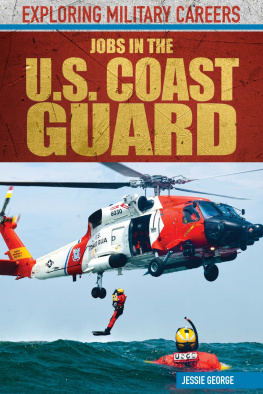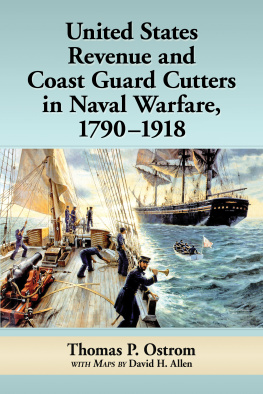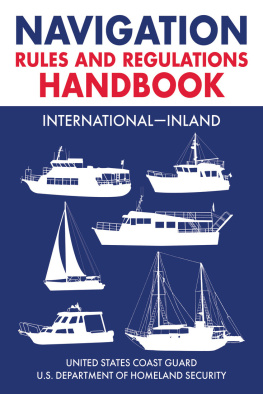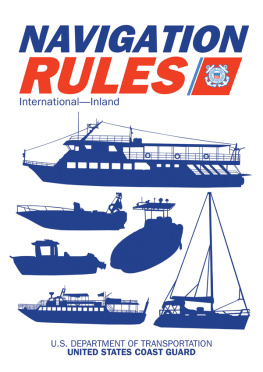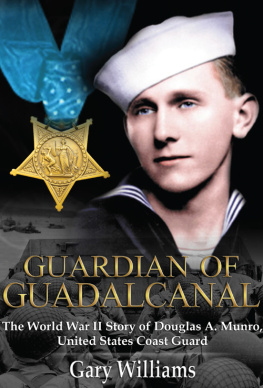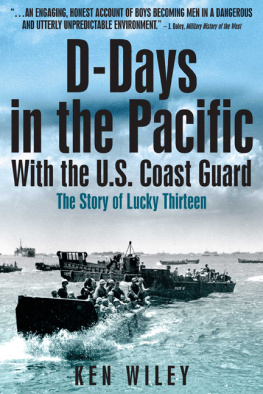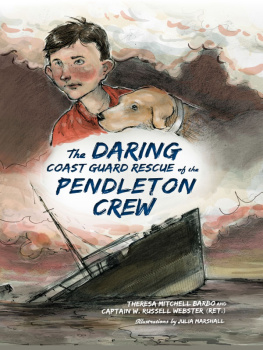Published in 2023 by The Rosen Publishing Group, Inc.
29 East 21st Street, New York, NY 10010
Copyright 2023 by The Rosen Publishing Group, Inc.
Portions of this work were originally authored by Judy Silverstein Gray and Taylor Baldwin Kiland and published as Careers in the U.S. Coast Guard. All new material in this edition was authored by Jessie George.
All rights reserved. No part of this book may be reproduced in any form without permission in writing from the publisher, except by a reviewer.
Cataloging-in-Publication Data
Names: George, Jessie.
Title: Jobs in the U.S. Coast Guard / Jessie George.
Description: New York : Rosen Publishing, 2023. | Series: Exploring military careers
| Includes glossary and index.
Identifiers: ISBN 9781499469950 (pbk.) | ISBN 9781499469967 (library bound) |
ISBN 9781499469974 (ebook)
Subjects: LCSH: United States. Coast Guard--Juvenile literature. | United States.
Coast Guard--Vocational guidance--Juvenile literature.
Classification: LCC VG53.G464 2023 | DDC 363.2860973--dc23
Some of the images in this book illustrate individuals who are models. The depictions do not imply actual situations or events.
Manufactured in the United States ofAmerica
CPSIA Compliance Information: Batch #CSRYA23. For further information, contact Rosen Publishing, New York, New York, at 1-800-237-9932.
CHAPTER 1
CENTURIES OF SERVICE
CHAPTER 2
UPDATES TO THE GUARD
CHAPTER 3
THE COAST GUARD IN THE COLD WAR
CHAPTER 4
MISSIONS IN THE MODERN WORLD
CHAPTER 5
WHAT IT MEANS TO SERVE
CHAPTER 6
AS DIVERSE AS THE NATION
CHAPTER 7
VESSELS OF THE COAST GUARD
CHAPTER 8
A BRIGHTER FUTURE ON THE COAST
CENTURIESOF SERVICE
T hough it has not always had the same name, the United States Coast Guard has a centu-ries-long history of protecting the nations ports. Its earliest missions in the young days of the United States were mainly related to regulating commercial interests, but the service has evolved to be a flexible force for maritime protection across the globe.
ANTIPIRACY POLICIES
The United States faced a growing national debt after the American Revolution, and the young country had trouble generating income to pay it. Alexander Hamilton, the first secretary of the treasury, came up with a plan to place taxes on imported goods brought into U.S. ports by foreign ships. The plan made sense, but piracy on the high seas and unpredictable weather were major threats to merchants who sought the safety of American ports. Life at sea was often hazardous.

As the first secretary of the treasury, Alexander Hamilton came up with policies forgenerating revenue and protecting merchant ships.
Hamilton was born and raised on the island of Nevis in the Caribbean, so he was familiar with smuggling ships that avoided paying taxes. He was well aware that piracy interfered with trade and national security.
In 1787, Hamilton was focused on coming up with a plan to create a maritime service with flexible capabilities. In an essay from The Federalist Papers, he argued that the United States should invest in a small fleet of well-armed ships that could stand guard at U.S. ports to protect merchants and citizens both. To create an organization that could fulfill this new patrol task, Hamilton established Americas Revenue Cutter Service. A cutter is a ship that is 65 feet (19.8 m) in length or longer. By founding the service, Hamilton ensured that his new tax collection plan would be able to succeed, helping generate funds for the young United States. The Tariff Act of August 4, 1790, included the purchase of a fleet of ten cutters. For this reason, Hamilton is often considered the father of the Coast Guard. As part of this new cutter fleet, he also provided 100 people to collect tariffs on the goods that could now safely come into American port towns. These supporters also kept an eye out for threats to the security of these ports, kicking off a U.S. tradition of service to the nationwith an emphasis on maritime safety and security.

The Revenue Cutter Service was the first form of what would eventually become the U.S. Coast Guard.
Because it was closely tied to collecting taxes, this new force was sometimes called the Revenue Marine. Overall, it operated as a maritime police force protecting U.S. coasts. Each of the new cutters had a crew of 10 sailors, each of whom earned a modest monthly salary. Hamilton also asked Congress to give each of these sailors a military rank.
These crews were made up of experienced sailing men who were also well-educated in the nations laws. One of their primary tasks was to conduct inspections of documents such as ship cargo lists, called manifests. They were often required to seize vessels that were violating the law. The important missions given to those first Revenue Cutter sailors required ships that were both fast enough to chase larger vessels at sea and quick enough to navigate safely through shallow ports and busy harbors. Ships were often given names appropriate for these tasks, such as Diligence and Vigilant, because they were always standing watch. Other vessels were named after American Revolution heroes such as Adjutant General Alexander Scammell. Still others were named for the 13 original states, including the Massachusetts. Many of the original vessel names that were assigned to ships in the early days of the Revenue Cutter Service are still used by the Coast Guard on newer vessels.
The first officer to receive a commission in the Revenue Cutter Service was Hopley Yeaton of New Hampshire. Yeaton made a name for himself by serving in the Continental Navy during the Revolutionary War. President George Washington appointed him to the outdated rank of master of a cutter in the Revenue Cutter Service on March 21, 1791. He was assigned to the 57-foot (17.4 m) schooner Scammel.
KEEPING THE LIGHT
The Coast Guard has been involved in safeguarding life and property at sea since the 1700s. Around the time of the American Revolution, there were very few buildings along shorelines, and much of the new nations coast was rocky. Night passage by ships could be dangerous, especially in windy or stormy weather. The early American colonies first constructed lighthouses in 1716 to help provide safer passage for ships by lighting the way to shore. These old lighthouses used lanterns lit by candles or whale oil, and they were staffed by brave volunteers. By 1812, lighthouse keepers were specifically assigned to lighthouses by the government, and they often used whale oil to ensure that their lanterns could burn continuously through the night. After 1822, some lighthouses were equipped with a special lens that could magnify or bend the light, thus providing better illumination for ships crossing over rocky channels.

